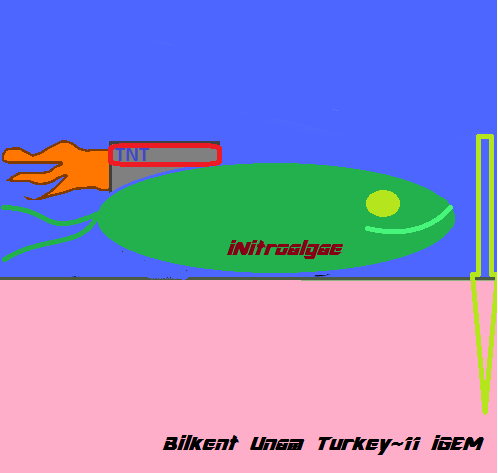Team:Bilkent UNAM Turkey
From 2011.igem.org
| Line 19: | Line 19: | ||
|- | |- | ||
| | | | ||
| - | '' | + | ''Our major project's abstract and motivation of us; |
| + | According to encyclopaedia algae have wide strand from unicellular to multicellular and they are photosynthetic. They are really good species to study on to produce biodiesel as a lot of people do. We choose working on algae for four major reasons: | ||
| + | Firstly; getting protein from algae is cheap and they can grow in wide area from soil to pink water. When we added our plasmid backbone to biobrick database other group can use it to get protein easily and amount also is a major problem for getting it from prokaryotes to clinical usage. | ||
| + | Secondly; Chlamydomonas reinhardtii is a common used model organism and it is easy to handle. With last decades people are really condense studying on it. This organism can also grow in dark with adding acetate as a source of carbon. | ||
| + | Thirdly; trinitrotoluene is a toxic material for the environment. After Edinburgh Team project we recognise it could be improved by this way. We have chosen NfsI gene as a nitroreductase which isolated from Enterobacter cloacae. Efficiency of NfsI gene for TNT reduction is good to accept to work with it. | ||
| + | And lastly; losing a family member because of mine is enough reason to put effort on it. We could have been a child of a dead man. Reality is that hundreds of thousands of people have been injured or killed by anti-personnel landmines. In Afghanistan, 350,000–500,000 have been killed or injured due to landmine explosions, and more occur daily. In Angola, there are approximately 26,000 amputees, and in Cambodia 30,000. In Mozambique, 6,000 people, mostly civilians, have been killed or maimed by landmines since 1980. Landmine Monitor reports have estimated that annually, 5,000 to 7,000 new casualties are caused by landmines and unexploded ordnance, the majority occurs in countries no longer involved in conflict. A child could die just for running after ball. | ||
| + | To conclude with; taking action to produce protein has some benefits and working with oxygen insensitive nitroreductase also has an advantage. We try to what scientists do. | ||
| + | (Save the people, save the world!) | ||
| + | )'' | ||
|[[Image:Bilkent_UNAM_Turkey_team.png|right|frame|Your team picture]] | |[[Image:Bilkent_UNAM_Turkey_team.png|right|frame|Your team picture]] | ||
|- | |- | ||
Revision as of 09:32, 9 July 2011
| Home | Team | Official Team Profile | Project | Parts Submitted to the Registry | Modeling | Notebook | Safety | Attributions |
|---|
| You can write a background of your team here. Give us a background of your team, the members, etc. Or tell us more about something of your choosing. | |
|
Our major project's abstract and motivation of us; According to encyclopaedia algae have wide strand from unicellular to multicellular and they are photosynthetic. They are really good species to study on to produce biodiesel as a lot of people do. We choose working on algae for four major reasons: Firstly; getting protein from algae is cheap and they can grow in wide area from soil to pink water. When we added our plasmid backbone to biobrick database other group can use it to get protein easily and amount also is a major problem for getting it from prokaryotes to clinical usage. Secondly; Chlamydomonas reinhardtii is a common used model organism and it is easy to handle. With last decades people are really condense studying on it. This organism can also grow in dark with adding acetate as a source of carbon. Thirdly; trinitrotoluene is a toxic material for the environment. After Edinburgh Team project we recognise it could be improved by this way. We have chosen NfsI gene as a nitroreductase which isolated from Enterobacter cloacae. Efficiency of NfsI gene for TNT reduction is good to accept to work with it. And lastly; losing a family member because of mine is enough reason to put effort on it. We could have been a child of a dead man. Reality is that hundreds of thousands of people have been injured or killed by anti-personnel landmines. In Afghanistan, 350,000–500,000 have been killed or injured due to landmine explosions, and more occur daily. In Angola, there are approximately 26,000 amputees, and in Cambodia 30,000. In Mozambique, 6,000 people, mostly civilians, have been killed or maimed by landmines since 1980. Landmine Monitor reports have estimated that annually, 5,000 to 7,000 new casualties are caused by landmines and unexploded ordnance, the majority occurs in countries no longer involved in conflict. A child could die just for running after ball. To conclude with; taking action to produce protein has some benefits and working with oxygen insensitive nitroreductase also has an advantage. We try to what scientists do. (Save the people, save the world!) ) | File:Bilkent UNAM Turkey team.png Your team picture |
| Team Example |
 "
"
